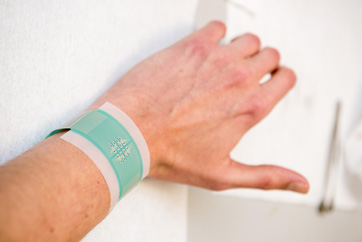Adhesive patch measures blood glucose without finger stick

A noninvasive, transdermal patch with an array of miniature “pixels” successfully measured blood glucose levels in the hair follicles of two healthy adults in in vivo models, according to findings from a proof-of-concept study published in Nature Nanotechnology.
Implantable and microneedle-based temporary glucose sensors, important advances for people with type 1 diabetes, are not an economically viable solution for the larger, growing population of those with type 2 diabetes, Adelina Ilie, PhD, a lecturer in the department of physics at the Centre for Graphene Science and the Centre for Nanoscience and Nanotechnology at the University of Bath, United Kingdom, and colleagues wrote. Noninvasive methods that could detect glucose levels in sweat, tears or saliva, for example, are limited by variability in the level of glucose detected and the unknown proportionality between the measured glucose concentration in such fluids to that in the blood, requiring a finger-stick calibration.
“The specific architecture of our array permits calibration-free operation, and it has the further benefit of allowing realization with a variety of materials in combination,” Ilie said in a press release. “We utilized graphene as one of the components, as it brings important advantages: Specifically, it is strong, conductive, flexible and potentially low-cost and environmentally friendly. In addition, our design can be implemented using high-throughput fabrication techniques, like screen printing, which we hope will ultimately support a disposable, widely affordable device.”
In in vivo testing, Ilie and colleagues analyzed data from two healthy adults who wore the wired, adhesive, 2 x 2 pixel array on the forearm, based entirely on commercially available screen printing and graphene ink-based electrodes. The patch samples glucose from the interstitial fluid via electro-osmotic extraction through individual follicular pathways in the skin, accessible via the pixels of the array. The design was based on a first-generation prototype that relied on thin film technology, including chemical vapor deposition graphene incorporated into a platinum nanoparticle-graphene hybrid material.

Glucose collects in tiny reservoirs and is measured, with readings taken every 10 to 15 minutes for several hours. Researchers monitored blood glucose for 6 hours, with the participants eating lunch and a snack during that time. Blood glucose was tracked via a commercial blood glucose meter (Accu-Chek Mobile, Roche) while the glucose extracted via reverse iontophoresis was monitored by two of the array’s pixel devices working in tandem.
The read-out values from the sensor were similar to those from the commercial blood glucose meter, according to the researchers.
“Importantly, control experiments show that, without [reverse iontophoresis], no glucose was detected, confirming that, under normal transdermal monitoring conditions, ie, when the user is not actively perspiring, there is no contamination of the [interstitial fluid]-borne glucose by that in the sweat,” the researchers wrote.

“The monitor developed at Bath promises a truly calibration-free approach, an essential contribution in the fight to combat the ever-increasing global incidence of diabetes,” Richard H. Guy, PhD, DSc, professor in the department of pharmacy and pharmacotherapy at the University of Bath, said in the release.
Researchers next plan to further refine the patch design to optimize the number of sensors in the array, to demonstrate full functionality during a 24-hour period and undertake clinical trials in people with diabetes, considering physical activity and environmental conditions, they wrote. – by Regina Schaffer
Disclosures: The Engineering and Physical Sciences Research Council, the Medical Research Council and the Sir Halley Stewart Trust funded this study. The researchers report no relevant financial disclosures.
